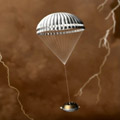by Paul Gilster | Jan 13, 2005 | Outer Solar System
Via the NASA TV site. Note the 2:45 PM slot, offering the first images from Titan (all times are EST).
January 14, Friday
3 a.m. – 3:30 a.m. – Live Coverage and Commentary “Cassini Turns Towards Titan – Interruption of Radio Contact” – JPL/ESA
5 a.m. – 6:30 a.m. – Live Coverage and Commentary “The Huygens Probe Enters the Atmosphere of Titan” – JPL/ESA
6:30 a.m. – 7 a.m. – JPL Commentary – JPL (Mission Coverage)
7:30 a.m. – 8 a.m. – ESA News Briefing “Mission Status” – JPL/ESA
8:30 a.m. – 9:15 a.m. – ESA Commentary on Huygens Probe Mission – JPL/ESA (Mission Coverage)
9:30 a.m. – 10 a.m. – JPL Commentary – JPL (Mission Coverage)
10 a.m. – 10:30 a.m. – ESA Commentary “Cassini Turns Back to Earth – Data Transmission Begins” – JPL/ESA
10:30 a.m. – 11:15 a.m. – JPL Commentary – JPL (Mission Coverage)
11:15 a.m. – 12 p.m. – Huygens Probe News Briefing – JPL/ESA (Mission Coverage)
1 p.m. – NASA Update with Sean O’Keefe – KSC
2:45 – 3:15 p.m. – ESA Commentary “Presentation of First 18 Images from Titan” – JPL/ESA (Mission Coverage)
5 p.m. – 5:30 p.m. – ESA Commentary and “Additional Images from Tital & B-Roll” – JPL/ESA
5:30 – 6 p.m. – JPL Commentary – JPL (Mission Coverage)
January 15, Saturday
5 a.m. – 6 a.m. – ESA Final Wrap Up on Huygens Probe Mission – JPL/ESA (Mission Coverage)
by Paul Gilster | Jan 13, 2005 | Outer Solar System
The Jet Propulsion Laboratory has posted a Huygens arrival schedule showing 4:51 AM EST as the time when Huygens powers up its transmitters. Pilot chute deployment now estimated at 5:16 AM EST, and surface touchdown at 7:34 AM EST. Also available at this page are multimedia files of Huygens arriving and a tracking animation.
 Image: An artist’s conception of hydrocarbon pools, icy and rocky terrain on the surface of Saturn’s largest moon Titan. Image by Steven Hobbs (Brisbane, Queensland, Australia).
Image: An artist’s conception of hydrocarbon pools, icy and rocky terrain on the surface of Saturn’s largest moon Titan. Image by Steven Hobbs (Brisbane, Queensland, Australia).
by Paul Gilster | Jan 13, 2005 | Outer Solar System
 The European Space Agency offers an outstanding animation showing the stages of Huygens’ descent to Titan’s surface tomorrow. Also available is an animation of the view from Cassini during the Huygens’ descent. Some interesting facts about the event:
The European Space Agency offers an outstanding animation showing the stages of Huygens’ descent to Titan’s surface tomorrow. Also available is an animation of the view from Cassini during the Huygens’ descent. Some interesting facts about the event:
Huygens’ atmospheric entry angle is a whopping 65° at a velocity of six kilometers per second, with touchdown planned for the daylight side in the southern hemisphere. The probe will pull 14g during deceleration.
The thermal shield will slow the probe to 400 meters per second within three minutes. Next comes deployment of a 2.6-meter pilot chute at 160 kilometers altitude. Within seconds, the pilot chute will pull off the probe’s aft cover; the main parachute (8.3 meters) will then deploy before the front shield is released.
At 110 kilometers, the main chute will be jettisoned; a smaller, 3-meter chute will then be deployed.
The DISR instrument (Descent Imager/Spectral Radiometer) will switch on its lamp for surface illumination and spectral analysis at several hundred meters altitude. Landing speed is 5 meters per second.
We are 20 hours away from Huygens descent as this is posted. A Huygens timeline is here (times listed are Central European — think UTC plus 1). ESA also offers a live Webcam covering Huygens and Cassini events from the European Space Agency Operations Center (ESOC) in Darmstadt. And you can take a virtual tour of ESOC that gives a glimpse of where the action will be during the Cassini/Huygens events tomorrow.
Image Credit: European Space Agency.
by Paul Gilster | Jan 13, 2005 | Outer Solar System
ESA provides an interesting explanation of a question that had puzzled more than one reader: given that the Huygens probe provided no telemetry at the time, how did controllers know that its Christmas Eve separation from the Cassini orbiter had been nominal? It’s true that Cassini was able to send data showing its own change in attitude due to the Huygens release, but how did we learn that Huygens was spinning at just the right rate (vital for a correct entry into Titan’s atmosphere)?
The answer: Huygens houses a weak magnetic field, despite attempts to render it ‘magnetically clean’ when it was constructed. The field is weak enough not to interfere with Cassini’s sensitive instruments, but turns out to be measurable by its magnetometers. Cassini’s Dual Technique Magnetometer (MAG) team used this data to establish the rate of Huygens’ spin.
From a news release from ESA:
Professor Michele Dougherty, Principal Investigator for MAG, said, “What was observed by MAG just after the probe separation on 25 December 2004, were weak but clear fluctuations in both magnetic sensors which reside on the 11-metre magnetometer boom. These fluctuations were a clear indication of the Huygens probe moving away from the Cassini orbiter. This signature confirmed the spin rate of the probe at 7.5 revolutions per minute, the ideal rate which was predicted, and that Huygens is well on its way to Titan.”
by Paul Gilster | Jan 12, 2005 | Outer Solar System
The Jet Propulsion Laboratory is offering this map of planned imaging coverage for the Huygens probe as it descends toward Titan’s surface on Friday.

Image: This map illustrates the planned imaging coverage for the Descent Imager/Spectral Radiometer, onboard the European Space Agency’s Huygens probe during the probe’s descent toward Titan’s surface on Jan. 14, 2005. The Descent Imager/Spectral Radiometer is one of two NASA instruments on the probe. The colored lines delineate regions that will be imaged at different resolutions as the probe descends. On each map, the site where Huygens is predicted to land is marked with a yellow dot. This area is in a boundary between dark and bright regions. Credit: NASA/JPL/Space Science Institute.
Click here for further information on the map and background about the descent. We are less than two days away from Huygens’ entry into Titan’s atmosphere, and Centauri Dreams seconds the JPL intro to this image: Go Huygens!
 Image: An artist’s conception of hydrocarbon pools, icy and rocky terrain on the surface of Saturn’s largest moon Titan. Image by Steven Hobbs (Brisbane, Queensland, Australia).
Image: An artist’s conception of hydrocarbon pools, icy and rocky terrain on the surface of Saturn’s largest moon Titan. Image by Steven Hobbs (Brisbane, Queensland, Australia). The European Space Agency offers an outstanding
The European Space Agency offers an outstanding 

